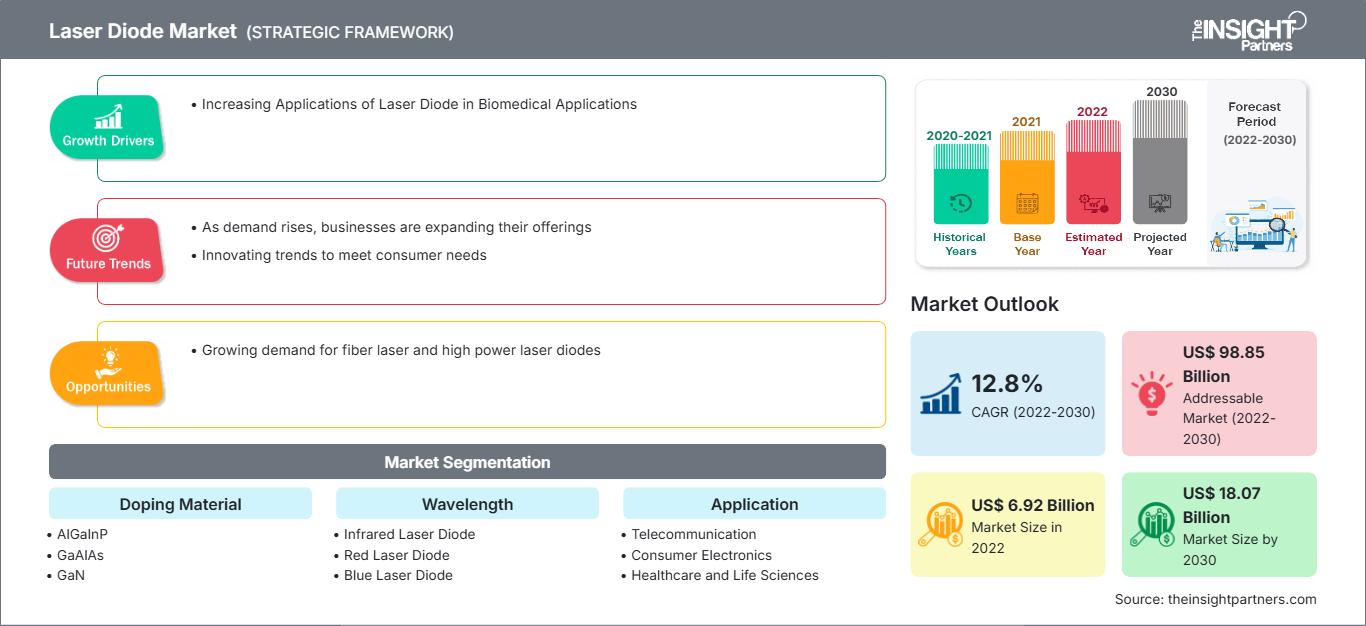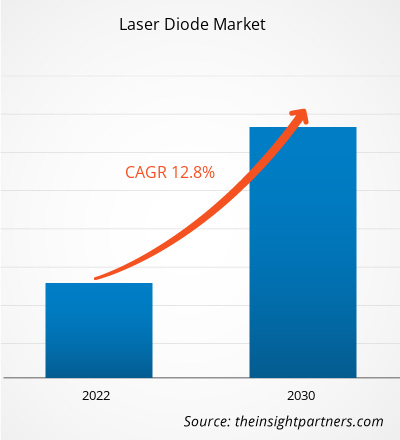The Laser Diode market is projected to grow from US$ 6.92 billion in 2022 to US$ 18.07 billion by 2030; it is expected to expand at a CAGR of 12.8% from 2022 to 2030. Growing demand for fiber laser and high-power laser diodes are expected to be key trends in the market.
Laser Diode Market Analysis
Laser diodes are widely used for various applications across hundreds of industries and markets, both industrial and commercial. The key functionality of laser diode devices is signal processing, which takes the form of sensing and communications, further increasing the demand for laser diodes for sensing applications. Fiber optics communications rely heavily on the signal processing power of laser diodes to carry signals for telephony, cable, and internet, contributing to the demand for laser diodes. Further, the growing adoption of laser diodes for sensing applications, such as smartphones for gesture control and facial recognition features, contributes to the laser diode market growth. The use of laser diode for data communication and LiDAR systems for automotive also propels the market growth. The rise in integration of technologies such as IoT across several industries such as healthcare, automotive, and building requires fiber optics communication technologies, which drives the demand and adoption of laser diodes.
Laser Diode Market Industry Overview
Laser diodes are semiconductor devices similar to light-emitting diodes (LED) but possess several unique attributes such as compact size, efficient work even in low input, and compatibility with modern electronics. Several advantages of laser diodes, such as higher intensity, simpler integration, consistent output, lower overall cost, and superior performance, propel their demand in numerous end-use industries, including automotive, consumer electronics, healthcare, and military & defense. Laser diodes are widely used in laser pointers and specific scientific and industrial applications (optical pumping of other lasers, spectroscopy, surface hardening, and others).
Laser diodes are extensively used in the telecommunication sector as they are easily modulated and coupled with light sources, which makes them an ideal option for fiber optics communication. The telecommunications and optical data storage industries are among the largest consumers of laser diodes as they have an exceptionally fast response time. The diodes are used in various electronics and instruments, such as rangefinders, barcode readers, and consumer electronics. In addition, low and high-power diodes are used broadly in the printing sector as light sources for scanning images and high-speed and high-resolution printing plate manufacturing.
Customize This Report To Suit Your Requirement
You will get customization on any report - free of charge - including parts of this report, or country-level analysis, Excel Data pack, as well as avail great offers and discounts for start-ups & universities
Laser Diode Market: Strategic Insights

-
Get Top Key Market Trends of this report.This FREE sample will include data analysis, ranging from market trends to estimates and forecasts.
Laser Diode Market Driver and Opportunities
Rise in Adoption of VCSEL for 3D Sensing Application
to Favor Market Growth
3D sensing technologies are used in various industries such as consumer electronics, medical, industrial, automotive, and automation. The 3D sensing technologies in these applications help to gain high precision and accuracy for the required task. For example, 3D sensing technologies in cameras help scan and render objects in 3D, one of the most common uses in smartphones, automobiles, drones, and robots. In consumer electronics such as smartphones, it is widely used for facial recognition and gesture control technologies. In industry automation, vertical-cavity surface-emitting laser (VCSEL) is used for accurate sensing technologies. In addition, it is widely adopted in virtual reality and gaming applications. Thus, the rise in these industries contributes to the requirement for 3D sensing technologies, which further demands VCSEL. To cater to the demand for VCSEL, several market players are introducing new VCSEL products. A few of them are mentioned below:
- In April 2022, TRUMPF launched new VCSEL products to expand their VCSEL product portfolio for 3D sensing in consumer and industrial applications.
- In March 2021, IQE PLC unveiled an IQVCSELTM product line to expand its VCSEL portfolio for service communication and advanced sensing markets.
- In March 2021, Lumentum Operations LLC launched five and six-junction VCSEL array products for advanced consumer and other 3D sensing applications.
Further, the use of VCSEL-based imaging increases the power and wavelength for 3D sensing. Its ability to produce higher power outputs makes it an optimal solution for its robotics and autonomous vehicle applications. Thus, the rise in the adoption of VCSEL for 3D sensing applications contributes to the laser diode market growth.
Increasing Applications of Laser Diode in Biomedical Applications
Because of direct electrical pumping, diode lasers are by far the most efficient light sources known. They can be produced in large quantities and at a reasonable cost because they are based on chip technology. Their small size allows for extremely tiny laser systems. All of these characteristics expand their application potential, including biomedical applications. This, in turn, is expected to create lucrative growth opportunities for the laser diode market during the forecast period.
Laser Diode Market Report Segmentation Analysis
The key segments that contributed to the derivation of the Laser Diode market analysis are coverage doping material, wavelength, and application.
- By application, the laser diode market is segmented into automotive, consumer electronics, healthcare, military & defense, and others. Laser diodes play a crucial role in modern telecommunications. They are commonly used in fiber-optic communication systems for numerous tasks, including optical fiber transmission, fiber optic networking, telecom data transmission, data storage, etc.
- The Laser diodes serve as efficient light sources for transmitting data through optical fibers, enabling high-speed communication over long distances. In fiber-optic networks, laser diodes are used in transmitters to convert electrical signals into optical signals for transmission through the fiber-optic cables. Moreover, it facilitates the transmission of voice, data, and video signals in telecommunication networks, ensuring rapid and reliable communication. Laser diodes contribute significantly to the efficiency and speed of data transmission in modern telecommunications infrastructure. Thus, laser diodes are used vastly in the telecommunication sector.
- Laser diodes are widely used in consumer electronics for various purposes. They are commonly found in devices such as DVD and Blu-ray players, optical disc drives, laser printers, and barcode scanners. Additionally, laser diodes are integral in the operation of a few types of laser pointers and range finders. Their compact size and efficiency make them suitable for applications where precise and focused light is required, contributing to the advancement of technology in consumer products. Thus, considering the various applications and suitable sizes, laser diodes are used widely in consumer electronics.
Laser Diode Market Share Analysis By Geography
Based on region, the market is segmented into North America, Europe, Asia Pacific, Middle East & Africa, and South & Central America.
The Asia Pacific laser diode market size was valued at US$ 3.46 billion in 2022 and is projected to reach US$ 10.77 billion by 2030; it is expected to register a CAGR of 15.2% from 2022 to 2030. The Asia Pacific laser diode market is segmented into Australia, China, India, Japan, South Korea, and the rest of Asia Pacific. China accounted for the largest share of the Asia Pacific laser diode market in 2022. China is one of the strong players in the semiconductor industry due to government initiatives such as Made in China 2025 to promote local manufacturing across the country. China's semiconductor industry consists of various companies contributing to the flourishing demand for semiconductors in several industries, such as automotive, consumer electronics, telecommunications, and aerospace.
A few of the major electronics manufacturers in the country include BYD Electronics and Huawei Technologies Co., Ltd., among others. Thus, to boost local production, the electronics companies invest to procure required technologies from China. For instance, in June 2020, Huawei Technologies Co., Ltd., a China-based manufacturer of telecommunications equipment and consumer electronics, invested in China-based VCSEL provider Vertilite to provide VCSEL laser diode supplies to Huawei Technologies Co., Ltd. Thus, such demand for laser diodes contributes to the laser diode market growth in the country.
Laser Diode Market Regional InsightsThe regional trends and factors influencing the Laser Diode Market throughout the forecast period have been thoroughly explained by the analysts at The Insight Partners. This section also discusses Laser Diode Market segments and geography across North America, Europe, Asia Pacific, Middle East and Africa, and South and Central America.
Laser Diode Market Report Scope
| Report Attribute | Details |
|---|---|
| Market size in 2022 | US$ 6.92 Billion |
| Market Size by 2030 | US$ 18.07 Billion |
| Global CAGR (2022 - 2030) | 12.8% |
| Historical Data | 2020-2021 |
| Forecast period | 2022-2030 |
| Segments Covered |
By Doping Material
|
| Regions and Countries Covered |
North America
|
| Market leaders and key company profiles |
|
Laser Diode Market Players Density: Understanding Its Impact on Business Dynamics
The Laser Diode Market is growing rapidly, driven by increasing end-user demand due to factors such as evolving consumer preferences, technological advancements, and greater awareness of the product's benefits. As demand rises, businesses are expanding their offerings, innovating to meet consumer needs, and capitalizing on emerging trends, which further fuels market growth.

- Get the Laser Diode Market top key players overview
Laser Diode Market News and Recent Developments
The Laser Diode market is evaluated by gathering qualitative and quantitative data post primary and secondary research, which includes important corporate publications, association data, and databases. A few of the developments in the Laser Diode Market are listed below:
- Mitsubishi Electric Corporation announced that it will begin shipping samples of its 50Gbps distributed-feedback (DFB) laser diode for optical-fiber communication in fifth-generation (5G) mobile base stations. (Source: Magic, Press Release, March 2022)
Laser Diode Market Report Coverage & Deliverables
The Laser Diode market forecast is estimated based on various secondary and primary research findings, such as key company publications, association data, and databases. The market report "Laser Diode Market Size and Forecast (2020–2030)" provides a detailed analysis of the market covering below areas-
- Laser Diode Market size and forecast at global, regional, and country levels for all the key market segments covered under the scope
- Laser Diode Market trends, as well as market dynamics such as drivers, restraints, and key opportunities
- Detailed PEST/Porter’s Five Forces and SWOT analysis
- Laser Diode Market analysis covering key market trends, global and regional framework, major players, regulations, and recent market developments
- Industry landscape and competition analysis covering market concentration, heat map analysis, prominent players, and recent developments in the Laser Diode Market
- Detailed company profiles.
Frequently Asked Questions
What are the deliverable formats of the Laser Diode market report?
What are the options available for the customization of this report?
What is the expected CAGR of the Laser Diode market?
Which are the leading players operating in the Laser Diode market?
What are the future trends of the Laser Diode market?
What are the driving factors impacting the Laser Diode market?
- Historical Analysis (2 Years), Base Year, Forecast (7 Years) with CAGR
- PEST and SWOT Analysis
- Market Size Value / Volume - Global, Regional, Country
- Industry and Competitive Landscape
- Excel Dataset
Recent Reports
Related Reports
Testimonials
Reason to Buy
- Informed Decision-Making
- Understanding Market Dynamics
- Competitive Analysis
- Identifying Emerging Markets
- Customer Insights
- Market Forecasts
- Risk Mitigation
- Boosting Operational Efficiency
- Strategic Planning
- Investment Justification
- Tracking Industry Innovations
- Aligning with Regulatory Trends





















 Get Free Sample For
Get Free Sample For